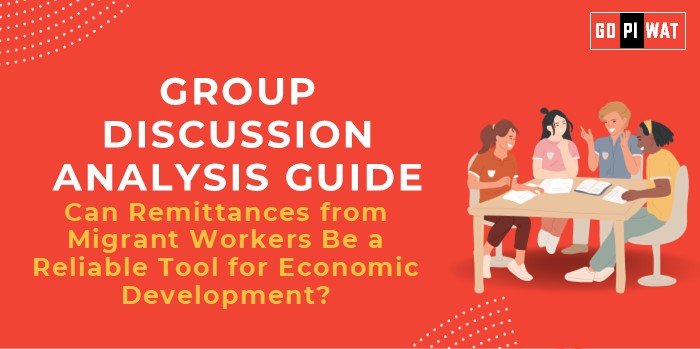📋 Group Discussion Analysis Guide: Can Remittances from Migrant Workers Be a Reliable Tool for Economic Development?
🌐 Introduction to the Topic
- 💡 Opening Context: Remittances from migrant workers constitute a lifeline for many economies, accounting for a significant percentage of GDP in developing nations. The World Bank reports global remittances reached $647 billion in 2022, underscoring their economic impact.
- 📜 Topic Background: Migrant remittances gained recognition as a development tool in the 2000s, particularly for their role in poverty reduction and financial inclusion. However, reliance on them poses questions of long-term economic sustainability.
📊 Quick Facts and Key Statistics
- 🌍 Global Remittances: $647 billion in 2022 – critical for developing nations.
- 🇮🇳 Top Recipient: India ($89 billion, 2022) – demonstrates their macroeconomic significance.
- 📊 Household Usage: 60% of remittances are spent on essentials like education and healthcare.
- 💰 Economic Contribution: 10%+ of GDP in countries like Nepal, Tonga, and Haiti.
👥 Stakeholders and Their Roles
- 🛠️ Migrant Workers: Primary earners and contributors to remittance flows.
- 🏠 Recipient Households: Use funds for consumption, education, healthcare, and small business investment.
- 🏛️ Governments: Facilitate remittance channels, develop policies to optimize their developmental impact.
- 🏦 Financial Institutions: Provide secure, affordable, and efficient remittance services.
- 🌍 International Organizations: Offer policy guidance (e.g., World Bank, IMF).
🏆 Achievements and ⚠️ Challenges
Achievements:
- ✅ Poverty Reduction: World Bank estimates suggest remittances reduce poverty by 11% in recipient households.
- 💳 Financial Inclusion: Encourages the use of formal banking channels.
- 📚 Investment in Human Capital: Significant spending on education and healthcare in recipient families.
- 💵 Foreign Exchange Reserves: Stabilizes currencies, especially in economies like the Philippines and Pakistan.
Challenges:
- ⚠️ Dependence Risks: Economies overly reliant on remittances can suffer if flows decline (e.g., during COVID-19).
- 📉 Brain Drain: Migration reduces skilled labor availability in home countries.
- 💸 High Transaction Costs: Average cost of global remittance transfers is 6.3% (2022).
- 🌍 Global Comparison:
- 🏅 Success: Philippines leveraged remittances to strengthen its BPO sector.
- 🔍 Challenges: Nepal’s reliance on remittances led to low domestic investment levels.
- 📚 Case Study: Mexico’s remittances (over $58 billion in 2022) helped stabilize its rural economies but underscored structural weaknesses.
📋 Structured Arguments for Discussion
- 📈 Supporting Stance: “Remittances provide financial stability and contribute to poverty alleviation, serving as a buffer during economic shocks.”
- 📉 Opposing Stance: “Over-reliance on remittances can stifle domestic job creation and perpetuate economic vulnerabilities.”
- ⚖️ Balanced Perspective: “While remittances promote immediate welfare, sustainable development requires structural reforms to complement their impact.”
💡 Effective Discussion Approaches
- 📊 Opening Approaches:
- 🌍 Discuss remittance statistics and their impact on specific economies.
- 📚 Highlight the dual role of remittances in economic resilience and dependency risks.
- 🔍 Counter-Argument Handling: Use global examples to propose reducing transaction costs and fostering productive use of remittances (e.g., savings, investments).
🔍 Strategic Analysis of Strengths and Weaknesses
- ✨ Strengths: Direct poverty alleviation, foreign exchange inflow, improved social spending.
- ⚠️ Weaknesses: Economic dependency, labor outflows, high transfer costs.
- 🚀 Opportunities: Technology-driven cost reductions, productive remittance utilization.
- ⛔ Threats: Global economic downturns, migration restrictions.
📘 Connecting with B-School Applications
- 📚 Real-World Applications: Designing remittance-linked microfinance products, policy-making for economic diversification.
- 💬 Sample Interview Questions:
- 🔎 “How can governments optimize remittance usage for economic development?”
- 🔎 “What lessons can be learned from countries like the Philippines or Nepal in managing remittances?”
- ✨ Insights for Students:
- 📊 Explore fintech innovations.
- 📜 Study remittance impact metrics and analyze migration policy frameworks.


